
I want you to try something. The next time you’re considering the purchase of a new car or SUV, first go to the closest Mazda retailer, or at least check out the Mazda stand at your local car show, and take a seat inside the equivalent model you’re considering buying from an alternative brand. I’m willing to guess you’ll soon be wondering why your current vehicle isn’t a Mazda, or if you should still be considering any competitive models for your next ride.
This is true even if you currently own something made by a premium brand, Aston Martin, Bentley or Rolls-Royce aside. That same Mazda may cause you to question why you paid so much more for your domestic, Japanese or European luxury vehicle. Step into one of Mazda’s Signature trim lines and you’ll be feeling glummer still.
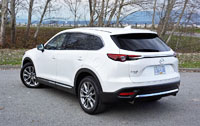
The top-line Signature trim is available in the Mazda6 mid-size sedan, plus Mazda’s CX-5 compact crossover SUV and the very CX-9 mid-size seven-passenger crossover being reviewed here. Together with the usual assortment of high-end features included in any given brand’s best equipped models, Signature trim includes such niceties as 19- to 20-inch alloy wheels, a powered steering column, a surround parking camera, front parking sensors to go along with the rear parking sensors already added, ventilated front seats, heated rear seats, and more depending on the model. Making it look and feel like it’s from a premium brand, not to mention a higher trim level from that premium brand, Mazda makes it even nicer by adding supple Nappa leather upholstery as well as real hardwood trim, my CX-9 Signature tester featuring Santos Rosewood on the centre console and all the door switchgear panels, front and rear.
Additionally, cloth-covered roof pillars are pulled up from lesser trims, while Mazda also boasts more pliable, padded premium surfaces than the majority of mainstream volume rivals, even in models not providing Signature trim lines like the recently redesigned Mazda3, making the independent automaker’s levels of refinement surprisingly good to those not yet initiated.
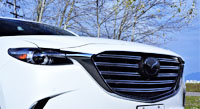
The CX-9 Signature shown here is as near premium as mainstream volume carmakers get. The multi-tiered dash is completely covered in padded leatherette that extends around to the door uppers front to rear. What’s more, the soft upper section of the instrument panel and harder lower composite panels are divided by a beautifully detailed metallic inlay that really feels genuine, this extending visually to the corner vents as well, plus the side door panels.
Thanks to my tester’s available Snowflake White Pearl exterior paint, it came standard with gorgeous Chroma Brown Nappa leather upholstery that also visually extends to the instrument panel, lower console and door inserts. It feels ultra rich on those doors thanks to a thick memory foam underlay, while a similar brown colour gets used for the thread stitching the leather-wrapped steering wheel and armrests together.
Piano black lacquer can be found inside too, but only in tastefully small applications around the shift lever and the doors’ power window switch panels, while the power mirror toggle is nicely detailed out in knurled aluminum like the infotainment system dial on the lower console. Plenty of satin-finish aluminum trim can be found through the cabin too, Mazda even coating the power seat controls with a satin metallic surface treatment for a truly upscale look.
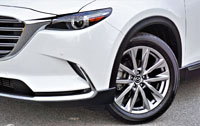
On the digital front, Mazda upgraded the primary gauge package in GT models and above for 2019. It looks like a regular three-dial cluster at first glance, but the centrally-mounted speedometer and two surrounding efficiency/range gauges are in fact part of a 7.0-inch colour display, this bookended by three analogue gauges to the left and right, including a tachometer, temperature readout and fuel gauge. This represents a big change over the previous 2016-2018 CX-9 gauge cluster, which included analogue gauges on the left and centre, plus a colour multi-info display on the right. Now the multi-info display is housed within the circular digital speedometer, and provides a whole host of helpful features.
Improving on the new gauge cluster is a head-up display unit that projects key info onto the windscreen, even including a speed limit reminder that I really appreciated.
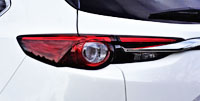
Over at dash centre is an 8.0-inch infotainment touchscreen with nice, attractive, high-resolution graphics. The display itself is a fixed, upright tablet-like design as seen on the CX-9 and other Mazda models for years. Premium brands first made this design popular and Mazda was one of the first mainstream marques to adopt it, while it’s only just starting to catch on amongst volume-branded challengers. My test model’s infotainment system featured an impressive new double-screen parking camera with the usual rearview monitor as well as a superb 360-degree bird’s-eye view, making negotiating a tight parking spot especially easy when combined with its front and rear sonar system.
Also new for 2019 is Apple CarPlay and Android Auto smartphone integration, plus SiriusXM Traffic Plus and Travel Link data services with information on real-time traffic, weather conditions, fuel prices, and sports scores, while the infotainment system also includes navigation with detailed mapping, excellent 12-speaker Bose audio with Centerpoint surround sound and AudioPilot noise compensation technologies, plus SurroundStage signal processing, HD and satellite radio, voice activation, Bluetooth phone connectivity with streaming audio, text message reading and response capability, plus more.
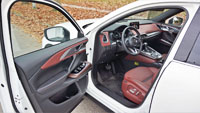
An infotainment feature that sets Mazda apart from its mainstream competitors yet aligns it with pricier luxury branded alternatives is its lower console-mounted controller. It’s made up of a big metal-edged rotating dial that navigates the display, plus a smaller audio volume knob, and a bunch of fast-access buttons. Using this interface to modulate the infotainment system will be more comfortable than stretching an arm to the dash to actuate the touchscreen, at least for some users, but this said you can still use the touchscreen for smartphone-style tap, swipe and pinch finger gestures, the latter function perfect for changing the scale on the navigation system’s map, for instance.
As you may have noticed earlier, the CX-9 has been around in its current form since 2016 when Mazda introduced this second generation, which makes its premium levels of interior refinement even more amazing. You’ll actually need to sidle up beside the CX-9 Signature in the new 2020 Hyundai Palisade or Kia Telluride if you want to improve upon its rich interior (although I must confess to not yet testing the 2020 Toyota Highlander). Also notable, this current generation CX-9 is no longer based on the Ford Edge, but instead rides on Mazda’s SkyActiv platform.

Made up of the mid-size SUV segment’s usual McPherson struts up front and multi-link setup in the rear with coil springs and a stabilizer bar at both ends, Mazda retuned it for 2019 to provide even better ride quality. Now it’s ideal for managing unkempt inner-city streets, overly large bridge expansion joints and otherwise poorly paved stretches of roadway elsewhere, while the latest CX-9 is also impressive on the open highway where its revised steering allows for better high-speed tracking.
Mazda’s dynamic pressure turbocharged SkyActiv-G 2.5-litre four-cylinder engine puts out ample passing power due to 250 horsepower, plus it gets up and goes quickly from standstill thanks to a whopping 320 lb-ft of torque. Understand that the CX-9 might look slim and stylish, but it’s in fact a sizeable seven-occupant crossover utility, but the highly efficient turbo-four nevertheless provides strong performance in town and more than enough when more open roads start winding. Sadly Mazda left steering wheel-mounted paddles off the menu, but the gear lever allowed for manual shifting when I wanted to extract as much performance from the powertrain as possible.
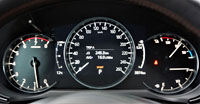
Interestingly, Mazda clearly specifies that the CX-9’s engine will only make full power when 93 octane gasoline or higher is fed into its tank, and knowing my colleagues all too well I’m going to guess that most use cheaper 87 octane when it comes time to refill. Therefore my tester was probably only making the 227 horsepower Mazda claims its capable of when lower grade gasoline is added, but it was still plenty quick. This may be because its impressive torque rating only loses 10 lb-ft without high-test fuel, and merely requires 2,000 rpm to provide full torque, so I personally wouldn’t waste any money on pricier fuel.
A metal rocker switch next to the shift lever allows for Sport mode, which improves acceleration due to the six-speed transmission’s ability to hold a given gear right up to redline, plus it won’t automatically shift when it spins up to the solid red line at 6,300 rpm, but instead holds its gear for more control through corners. This is a very rare feature in this mostly practical market segment, and therefore provides the CX-9 with more excitement than its rivals, despite only using a six-speed autobox. Together with its agile suspension setup, notably upgraded for 2019, and its fairly direct feeling engine-speed-sensing variable power-assist rack-and-pinion steering system, which collectively iron out tight curving roadways impressively, it’s a very well sorted SUV.
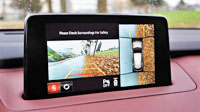
G-Vectoring Control technology carries over from the previous CX-9, the technology seamlessly moving more torque to the front wheels during corner entry and then sending it rearward when exiting. To most it will be imperceptible, only adding stability that’s especially welcome amid inclement weather like the rainstorm I experienced during my test week. This is when I was also glad Mazda makes its i-Activ AWD system standard in trims above the base GS model, putting all of my Signature model’s 255/50R20 all-season tires to work.
All-wheel drive will be standard next year, so Mazda won’t be able to claim its current FWD model’s most efficient 10.6 L/100km city, 8.4 highway and 9.6 combined fuel economy rating. The AWD CX-9’s fuel economy is rated at 11.6, 9.1 and 10.5 respectively, incidentally, which despite making significantly more than the Kia Sorento is nearly as efficient by comparison, the Korean SUV achieving 11.2 in the city, 9.0 on the highway and 10.2 combined, whereas the V6-powered Highlander somehow gets a Transport Canada rating of 12.1 L/100km city, 9.0 highway and 10.6 combined.
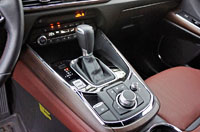
Igniting the CX-9’s engine only requires the press of a dash-mounted button, while access to the interior comes via proximity-sensing keyless entry. You’ll need to press on of the less than subtle black buttons on the front door handles to make the system work, and take note that Mazda hasn’t added a set of these buttons to the rear door handles like some others, but I must say that once inside the CX-9’s driver ergonomics are better than many of its competitors. The 10-way powered driver’s seat includes the usual fore, aft, up, down, tilt and recline functions, plus two-way powered lumbar support that actually pressed up against the small of my back perfectly (what luck!), but you might want to personally check this feature out for yourself. All said my tester proved wonderfully comfortable throughout my test week, with some of that credit needing to go to the powered tilt and telescopic steering column’s long reach.
Sitting behind my driver’s seat I found the second row window seat roomy, comfortable and supportive all-round. A wide centre armrest folds down when three abreast is a crowd in back, replete with a set of cupholders as per every other competitor in this segment, while the tri-zone automatic climate control system gets an attractive interface on the backside of the front console, featuring rocker switches for the previously noted three-way heated rear window seats.

The outboard second-row seats easily slide forward for ample access to the rearmost row, and while the third row offers a nice, comfortable set of backrests and lower cushions, there’s not much room for an average sized adult’s knees and feet unless the 60/40-split second row is pushed far enough forward that it’ll start feeling claustrophobic for its passengers. Thus the third row better used by smallish adults or children.
When that third row is in use there’s not much space for cargo, but nevertheless Mazda says that it’s good for 407-litre loads. I certainly never had need for the rearmost seats so I left them tucked away most of the time, which allowed for a very accommodating 1,082 litres (38.2 cu ft) of total cargo volume. The second row lies flat when required too, but being that it’s divided with a less than optimal 60/40 split it’s impossible to use the rear seat heater when stowing skis or other long items longitudinally. Better would be a centre pass-through or even more optimal 40/20/40 split-folding second row, but at least the CX-7 maxes its cargo capacity out at a sizeable 2,017 litres (71.2 cu ft) when all seats are lowered. The cargo area is properly finished as well, with carpeting protecting three-quarters of each sidewall, while a sturdy load floor can be lifted to expose a shallow carpeted storage compartment below.
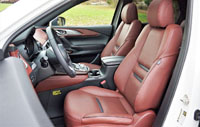
Other notable storage areas include an overhead console sunglasses holder, a big open area ahead of the shift lever, a large bin below the front centre armrest, and lastly the glove box that’s quite large and lined with a nice velvet-like material. Yes, Mazda certainly goes all the way in dressing up its flagship SUV.
Refinement in mind, Mazda stuffs all of the unseen areas with sound-deadening insulation, while the windshield and front windows use noise-isolating glass. The CX-9’s body is ultra-rigid too, while aforementioned improvements made to the steering and suspension systems help to eliminate unwanted noise while improving the SUV’s overall feeling of solidity. Everything from the way the CX-9’s doors close to its general driving dynamics make it seem like it should be badged by a luxury carmaker, while its very quiet inside too.

Peace of mind is important too, and to this end the CX-9 Signature provides one of the more advanced collections of active and passive safety gear available. Of course all the usual active and passive safety features are included, although these are supported with forward obstruction warning, Smart Brake Support and Smart City Brake Support autonomous emergency braking with pedestrian detection, advanced blind spot monitoring, rear cross traffic alert, lane departure warning, lane keeping assist, traffic sign recognition, new seatbelt reminders on the second- and third-row seats, adaptive cruise control with stop and go, and more.
Other premium-like features include an electric parking brake, a new frameless auto-dimming rearview mirror, new power-folding door mirrors, a Homelink universal garage door opener, a revised overhead console with LED overhead and ambient lighting plus a better designed LED room lamp control switch, while its heatable leather-wrapped steering wheel with cross-stitched detailing is a wonderful way to wake up on a cold winter morning.

Additionally, the previously noted driver’s seat includes memory, while the CX-9 Signature also adds an eight-way powered front passenger’s seat with power lumbar, plus rear side window sunshades and more for only $51,500 (plus freight and fees), which is great value when put up beside luxury branded crossover SUVs with the same level of features, and just right when comparing volume-branded competitors with similar equipment. The only obvious feature void was the lack of a panoramic sunroof, the regular sized power moonroof overhead looking a bit too commonplace this day and age.
Speaking of the CX-9’s price and features, be sure to check out its various trims, packages and individual options at our 2019 Mazda CX-9 Canada Prices page, plus learn about available manufacturer rebates, in-house financing/leasing deals, and dealer invoice pricing to save even more. In fact you can get up to $2,500 in additional incentives on the 2019 CX-9 (at least you could at the time of writing), or up to $1,000 off when choosing the virtually identical 2020 CX-9.

Saving what some will claim as the CX-9’s best attribute for last, its dramatic yet tasteful styling could easily come from a high-end premium automaker. The SUV’s satin-silver grille is big and oh-so dramatic, its lower half even including night illumination, while full LED headlamps with automatic high beams, adaptive cornering capability and auto self-levelling seem like extensions of the grille’s chromed end pieces. An aerodynamic lower front fascia features integrated LED fog lamps, while slim LED tail lamps highlight the SUV’s rear quarters, and elegant satin-chrome trim can be found from front to back. Overall, the CX-9 is one sleek and elegant looking mid-size, three-row crossover SUV, which certainly makes it stand out in its crowded segment, just in case its impressive luxury, host of features, excellent driving dynamics and complete suite of advanced driving assistive systems haven’t caused you to sign on the dotted line.
Yes, like I said at the beginning of this review, the CX-9 will make a good first impression if you give it a chance. I highly recommend it.
Story and photo credits: Trevor Hofmann
